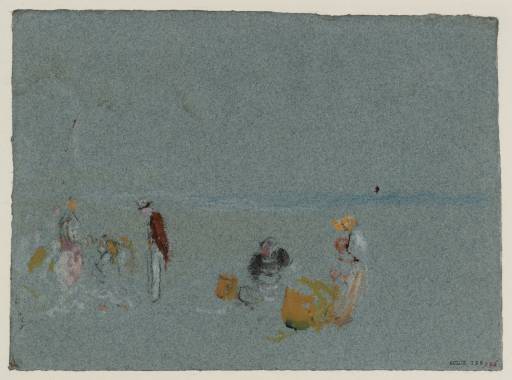Joseph Mallord William Turner Figures on the Beach: ?Boulogne c.1830
Joseph Mallord William Turner,
Figures on the Beach: ?Boulogne
c.1830
Figures on the Beach: ?Boulogne c.1830
D24791
Turner Bequest CCLIX 226
Turner Bequest CCLIX 226
Gouache on blue wove paper, 139 x 190 mm
Stamped in black ‘CCLIX 226’ bottom right
Inscribed in red ink ‘22’6’ bottom right
Stamped in black ‘CCLIX 226’ bottom right
Inscribed in red ink ‘22’6’ bottom right
Accepted by the nation as part of the Turner Bequest 1856
Exhibition history
1974
Turner 1775–1851, Royal Academy, London, November 1974–March 1975 (391, as ‘Figures on a Beach’).
1983
Turner and the Human Figure: Watercolours from the Turner Bequest, Loaned by the British Museum, Tate Gallery, London, December 1983–July 1984 (no catalogue, as ‘Figures on the beach; probably at Boulogne’).
2008
Coasting: Turner and Bonington on the Shores of the Channel, Nottingham Castle, November 2008–February 2009, Ferens Art Gallery, Hull, February–May, Hastings Museum & Art Gallery, May–August 2009 (no. 19, as ‘Figures on the Beach; ?at Boulogne’, reproduced in colour).
References
1830
A.J. Finberg, A Complete Inventory of the Drawings of the Turner Bequest, London 1909, vol.II, p.803, CCLIX 226, as ‘Figures on the beach; probably at Boulogne’, c.1830.
1974
Martin Butlin, Andrew Wilton and John Gage, Turner 1775–1851, exhibition catalogue, Royal Academy, London 1974, p.116 no.391 as ‘Figures on a Beach’.
1989
Martin Butlin, Mollie Luther and Ian Warrell, Turner at Petworth: Painter and Patron, London 1989, p.123 note 114.
2008
David Blayney Brown, Sarah Skinner and Ian Warrell, Coasting: Turner and Bonington on the Shores of the Channel, exhibition catalogue, Nottingham Castle 2008, pp.27, 29, pl.19 (colour), p.71 no.19 as ‘Figures on the Beach; ?at Boulogne’.
This colourful sketch shows two groups of figures on a beach. The group on the left includes two standing gentlemen, one of whom, seemingly surveying the activity of a crouching cluster of figures, wears a hat, a vibrant red tailcoat and appears to be holding a stick. The other group includes two women, one of whom wears a bonnet and is perhaps carrying a small child. The baskets depicted beside them allude to the collection of shellfish or fishing bait. In the background, a faint strip of blue paint in the background denotes the seashore. The black dot on the horizon may represent a spillage or fleck of stray paint, or else it may serve to represent a boat or structure out at sea.
Turner produced a number of drawings showing figures on the beach in the late 1820s and into the 1830s. Presumed to represent either English or French coastlines associated with the artist’s Continental travels, they are, for the most part, unidentified in terms of specific locations and have been generally categorised as miscellaneous or generic, often on-the-spot, sketches. The majority of these are compiled and described in a separate section of the present catalogue dedicated to the subject (see Matthew Imms’s ‘Figures on a Beach c.1826–45’).
In the case of the present picture, the tentative suggestion of the scene depicted being ‘at Boulogne’ explains its separate consideration. In his 1909 Inventory of the Turner Bequest, A.J. Finberg described the scene as ‘probably at Boulogne’,1 although it is unclear what persuaded the cataloguer to suggest this subject. It is certainly the case that Turner produced many drawings of the coast in and around the town (see under Tate D20291; Turner Bequest CCXXIV 1 for a summary of the artist’s Boulogne imagery), and it is possible that the dot of black paint in the distance was interpreted as depicting one of the region’s offshore forts, a subject which repeatedly preoccupied the artist (see, among others: D20291; CCXXIV 1; D19428; CCXV 16a, in the 1825 Holland, Meuse and Cologne sketchbook; and D24892; CCLX 56). However, as the Turner scholar Ian Warrell has observed, it is difficult to prove conclusively whether these types of sketches of figures on the beach were made in England or France.2
The drawing has been cited as an example of the potential connection between Turner’s work and that of Richard Parkes Bonington (1802–1828), whose coastal sketches of his adopted home of Northern France typically display a similar style and character. Turner would have first encountered Bonington’s work in the mid–1820s, from which was born ‘a creative relationship that accommodated difference and in which influence passed both ways’.3
Verso:
Blank except for inscriptions, in pencil ‘O | 251’ top left, ‘226’ top left, and ‘D24791’ bottom right.
Hayley Flynn
April 2024
How to cite
Hayley Flynn, ‘Figures on the Beach: ?Boulogne c.1830’, catalogue entry, April 2024, in David Blayney Brown (ed.), J.M.W. Turner: Sketchbooks, Drawings and Watercolours, Tate Research Publication, November 2024, https://www

